The Wind in the Worlds
On other planets, the weather can be frightful.
Share this:
- Share via email (Opens in new window) Email
- Click to share on Facebook (Opens in new window) Facebook
- Click to share on X (Opens in new window) X
- Click to share on Pinterest (Opens in new window) Pinterest
- Click to share on Reddit (Opens in new window) Reddit
- Share to Google Classroom (Opens in new window) Google Classroom
- Click to print (Opens in new window) Print
By Emily Sohn
If you could live near Jupiter’s famous Great Red Spot, your weather forecast might sound something like this: Expect lightning storms and winds gusting to 340 miles per hour for the next few hundred years.
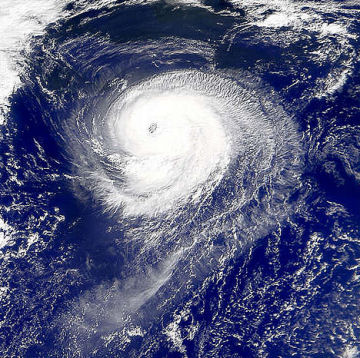 |
|
On Earth, hurricane-force winds such as those that formed Hurricane Alberto (pictured above) can blow as “slowly” as 74 miles per hour. By comparison, winds in Jupiter’s Great Red Spot move at speeds up to 340 miles per hour.
|
| NASA Goddard Space Flight Center |
On Venus, you’d wake up to a temperature of 890ºF, which is hot enough to melt lead. Huge, planetwide dust storms could disrupt your plans on Mars. And Neptune’s 900-mile-per-hour (mph) winds would make the worst hurricanes on Earth seem like gentle breezes.
Weather watching
Just as meteorologists study the weather on Earth, planetary scientists study the weather on other planets. What these scientists find won’t cancel soccer games or predict a good day at the beach, but their research might help explain what makes planets and their weather systems, including those on Earth, tick.
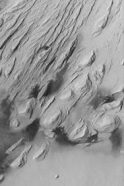 |
|
Wind can alter a planet’s surface by covering up meteor craters and shaping landscapes. This photo shows the effects of wind erosion on Mars.
|
| NASA Jet Propulsion Laboratory |
Learning about weather throughout the solar system could also give us a sense of how global warming will affect Earth, says planetary scientist David Atkinson of the University of Idaho in Moscow. That’s because each planet is like a natural experiment, showing what our planet might be like under different conditions.
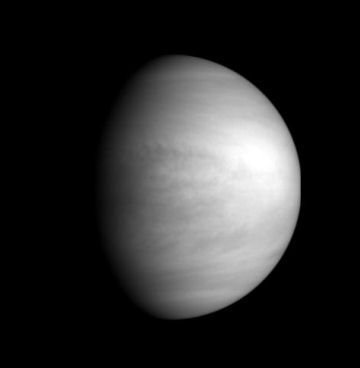 |
|
Thick clouds perpetually cloak Venus, obscuring the planet’s hot surface.
|
| NASA Jet Propulsion Laboratory |
“Planets form a laboratory for studying winds on Earth,” Atkinson says. “We can’t move Earth or speed it up or stop it from spinning. These are our experiments. We study the planets.”
Getting wind of wind
Weather and wind can occur only on planets or other objects that are surrounded by layers of gases, called atmospheres.
At least 12 objects in our solar system fit that category, says planetary scientist Timothy Dowling of the University of Louisville in Kentucky. Scientists have discovered atmospheres on the sun, on most of the planets, and on three moons.
Winds, which drive weather systems, need an energy source to get them going. On Earth, energy from the sun heats some pockets of air, while other pockets remain cold. Hot air then moves toward cold air, creating wind.
Probing the wind
Since the far reaches of the solar system get less of the sun’s energy than Earth does, scientists had expected that the cold, distant planets would be less windy than our planet is. But when researchers began launching probes to other planets, surprises started pouring in.
To check winds on another planet, scientists send a measuring device into its atmosphere. On a planet with no wind, gravity makes the probe drop straight down toward the planet’s surface. If the probe falls at an angle, researchers know that it’s being pushed by wind, and they can then calculate the wind’s speed and direction. So far, probes have measured winds below the clouds on Venus, Jupiter, and Saturn’s moon Titan.
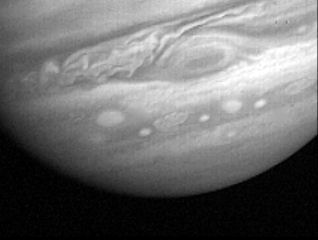 |
|
Click the image above (or click here) to watch a time-lapse movie of Jupiter’s Great Red Spot. The movie shows how conditions evolved over 66 Jupiter days, which last about 10 hours each.
|
|
NASA Jet Propulsion Laboratory
|
Using these and other techniques, scientists have measured 200-mph winds in the upper atmosphere of Jupiter, 800-mph winds on Saturn, and 900-mph winds on Neptune. On Earth and Mars, which are much closer to the sun, winds in the upper atmosphere average only 60 mph.
From Neptune, the sun is so far away that it “looks just like a bright star,” Dowling says. “Yet winds are just screaming around the planet. It’s an amazing contradiction.”
And that’s not the only mystery blowing in the planetary wind.
Mysterious winds
On Earth, winds get faster as you get higher in the atmosphere. So, for example, airplanes experience more wind than cars do. And we tend to feel more wind on mountaintops than on prairies. The same is true on Venus and Mars.
On Saturn’s moon Titan, however, the Huygens probe found a different pattern during its descent in 2005. As expected, the winds were strongest near the outer edges of the atmosphere. They then dropped to almost nothing as the probe moved toward Titan’s surface. About halfway down, however, the gusts picked up. Then, closer to the moon’s surface, they dwindled again.
Winds increase deep inside the atmosphere of Jupiter too, Atkinson says, even though computer models had predicted that the opposite would be true.
“What that tells us,” he says, “is that there is most likely energy down below that is coming outward.”
Another puzzle is the link between an object’s spin and the strength of its winds. On most planets and moons with atmospheres, winds blow in the direction in which the object spins. This suggests that spinning helps get wind whipping.
Venus, however, takes 243 Earth days to make a single rotation. Yet wind zips around Venus 60 times as fast as the planet spins, Dowling says. Titan’s wind also outraces its spin.
As scientists attempt to decipher these unexpected findings, the planetary weather keeps changing.
Last October, researchers using the Hubble Space Telescope found the first evidence of a dark spot on Uranus. The spot is probably an enormous, rotating storm, like Jupiter’s long-standing Great Red Spot, Neptune’s Great Dark Spot, and Saturn’s Great White Spots.
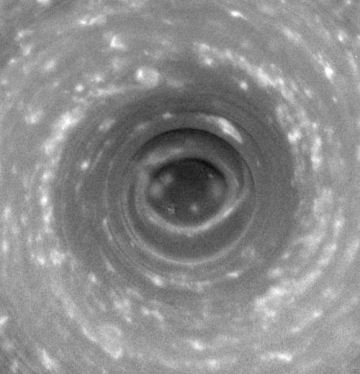 |
|
Shadows highlight the steep walls of clouds surrounding a swirling, hurricanelike vortex near Saturn’s south pole.
|
| NASA Jet Propulsion Laboratory/Space Science Institute |
Last fall, the Cassini spacecraft took pictures of a raging storm near Saturn’s south pole. Unlike Saturn’s Great White Spots, this storm has a distinct center, called an eye. The storm also has a steep wall of clouds along its edges. The clouds are similar to a hurricane on Earth, but many times stronger. It’s the first hurricanelike storm ever observed on another planet.
Forecasting the future
Scientists are using the data they collect from planets other than Earth to help create a grand theory of what causes weather throughout the solar system. They want to know why some storms last longer than others, and why some become so powerful.
Researchers also hope to use this information to create computer programs that will help them make better long-term predictions about storms, droughts, and the consequences of climate change on Earth.
“Could Earth turn into Venus, which is as hot as an oven?” Dowling asks.
“Could Earth turn into Mars, which is a cold desert? Could it turn into Titan, which is a smoggy world with thick clouds and no life?”
For answers about Earth, scientists are looking to other worlds.
Going Deeper:







